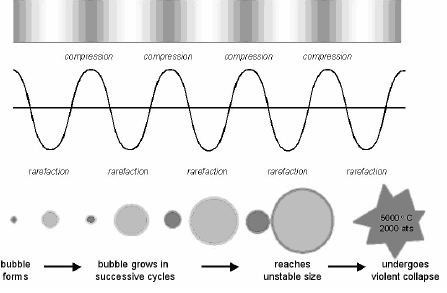SKEDSOFT
Detection of Ultrasonic Waves: Ultrasonic waves propagated through a medium can be detected in a number of ways. Some of the methods employed are as follows:
- Kundt’s tube method: Ultrasonic waves can be detected with the help of Kundt’s tube. At the nodes, lycopodium powder collects in the form of heaps. The average distance between two adjacent heaps is equal to half the wavelength. This method cannot be used if the wavelength of ultrasonic waves is very small i.e., less than few mm. In the case of a liquid medium, instead of lycopodium powder, powdered coke is used to detect the position of nodes.
- Sensitive flame method: A narrow sensitive flame is moved along the medium. At the positions of antinodes, the flame is steady. At the positions of nodes, the flame flickers because there is a change in pressure. In this way, positions of nodes and antinodes can be found out in the medium. The average distance between the two adjacent nodes is equal to half the wavelength. If the value of the frequency of ultrasonic wave is known, the velocity of ultrasonic wave propagated through the medium can be calculated.
- Thermal detectors: This is the most commonly used method of detection of ultrasonic waves. In this method, a fine platinum wire is used. This wire is moved through the medium. At the position of nodes, due to alternate compressions ad rarefactions, adiabatic changes in temperature takes place. The resistance of the platinum wire changes with respect to time. This can be detected with the help of Callendar and Garrifith’s bridge arrangement. At the position of the antinodes, the temperature remains constant. This will be indicated by the undisturbed balanced position of the bridge.
Quartz crystal method: This method is based on the principle of Piezo-electric effect. When one pair of the opposite faces of a quartz crystal is exposed to the ultrasonic waves, the other pairs of opposite faces developed opposite charges. These charges are amplified and detected using an electronic circuit.
PROPERTIES OF ULTRASONIC WAVES
- Ultrasonic waves are having frequencies higher than 20 KHz and hence they are highly energetic and their wavelengths are small.
- Due to their small wavelengths, the diffraction is negligible. Hence, they can be transmitted over a long distances without any appreciable loss of energy.
- When they are passing through a medium, at discontinuities, they are partially reflected and this property is used in Non-Destructive Technique (NDT).
- When the ultrasonic wave is absorbed by a medium, it generates heat.
- They are able to drill and cut thin metals.
- At room temperature, ultrasonic welding is possible.
- They mix molten metals of widely different densities to produce alloys of uniform composition.
- Using ultrasonic wave, acoustic grating can be formed in a liquid.
ACOUSTIC CAVITATION: In general, cavitation is the phenomenon where small and largely empty cavities are generated in a fluid, which expand to large size and then rapidly collapse. When the cavitation bubbles collapse, they focus liquid energy to very small volumes. Thereby, they create spots of high temperature and emit shock waves. The collapse of cavities involves very high energies.
Power ultrasound enhances chemical and physical changes in a liquid medium through the generation and subsequent destruction of cavitation bubbles. Like any sound wave ultrasound is propagated via a series of compression and rarefaction waves induced in the molecules of the medium through which it passes. At sufficiently high power the rarefaction cycle may exceed the attractive forces of the molecules of the liquid and cavitation bubbles will form. Such bubbles grow by a process known as rectified diffusion i.e. small amounts of vapour (or gas) from the medium enters the bubble during its expansion phase and is not fully expelled during compression. The bubbles grow over the period of a few cycles to an equilibrium size for the particular frequency applied. It is the fate of these bubbles when they collapse in succeeding compression cycles which generates the energy for chemical and mechanical effects. Cavitation bubble collapse is a remarkable phenomenon induced throughout the liquid by the power of sound. In aqueous systems at an ultrasonic frequency of 20 KHz
each cavitation bubble collapse acts as a localised "hotspot" generating temperatures of about 4,000 K and pressures in excess of 1000 atmospheres

Application: The acoustic cavitation is useful in the cleaning process. This type of cleaning has proven to be the most effortless, quick and efficient method of cleaning known today. The applications are virtually limitless. Ultrasonic cleaning is state-of-the-art technology. It utilizes a digital generator powering transducers submerged in a tank of hot water. The transducers vibrate at a frequency of 40 KHz creating millions of tiny bubbles that form and implode. This repeated formation and implosion creates a gentle cleaning action known as Cavitation. Cavitation has the ability to not only clean the surfaces of items, but also penetrate into the difficult to clean internal and crevice areas. It is the safest and most gentle form of cleaning. Ultrasonics will not scratch, pit or damage items the way that conventional cleaning methods can. Ultrasonic cleaners accomplish the cleaning task within seconds. It can remove build-up of dirt, grime, grease or soot. Hard-to-clean areas such as the grooves of club heads, the lettering on the heel, and the grips also become clean, adding longevity of use and luster to the club.